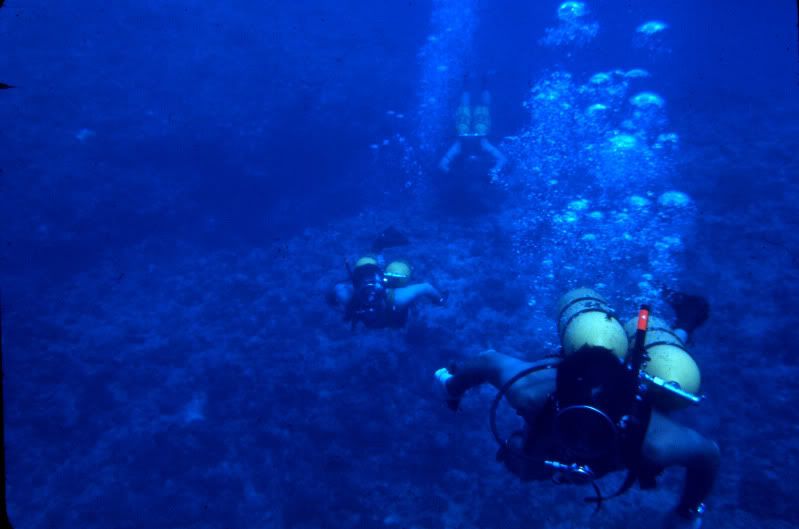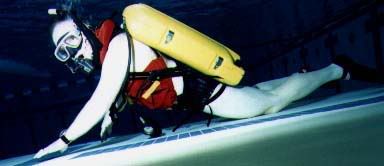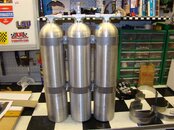Elmer and all,
I have had an idea for a while about how to make a triple set without a triple manifold. If you'll remember, the original Cousteau Aqualung set of triples did not have a triple manifold, but instead had a very small metal tube from one tank to the other, with one on the top and one bottom of the set. The bottom set had a valve, which in the patent uses a word which may be censored here, connecting the cylinder to the other two. This valve was open for filling, then closed for diving. This was the reserve cylinder, and the reason the Cousteau divers could dive safely without a J-reserve manifold or a SPG. They had 1/3 of their air held in reserve.
There is one other piece of information you need to know about, and that is a peculiarity of the AMF Voit MR-12 series of regulators. If you look closely at the original MR-12 second stage, you will see that the seat is reversible. This is item number 28, part number 1665-111, the "Demand Valve Housing." This housing was made for the military, in that if in the field it started leaking, you simply unscrewed it, reversed it (changed the O-ring), and screwed it back in. It is this part that is a key for making a triple tank system without a triple tank manifold.
Now, envision this set. You have three 40 cubic foot aluminum cylinders, all banded together tightly, with the right one upside down. Each of these cylinders has its original K-valve. The banding can be done with simple stainless steel screw bands, pulled tightly in the center by a metal or wooden piece to ensure that the cylinders are bound tightly. These bands can bind the two outside tanks to the inside tank independently, if the metal screw bands are too short for full coverage.
So now you have the cylinders, and need a harness. A vintage cotton harness would do wonderfully here, or you could simply make a Cousteau-style harness with only shoulder straps and a crotch strap. The crotch strap would hook into the weight belt rather than having a waist strap on the system. This is how the Cousteau divers used their triple sets for several decades; I've tried it and it works extremely well.
But, you say, we have to have three regulators, and they are independent; you've forgotten the MR-12's Demand Valve Housing. Not only is this housing reversible in the MR-12, but it is also set up so that you can screw it out of the regulator, and into another LP hose (regulator side). What does this do? Well, it allows you to set up a Royal Aquamaster, or even better, a Phoenix Royal Aquamaster or Mossback Mk III or Trieste II, so that the main double hose regulator is tied into the first stages of the other two regulators on the other two tanks. You can have the right tank reversed, and turn it off too to give you the 1/3 backup that the Cousteau divers had. The two outside first stages would have to be adjusted to almost identical IPs with the double hose on your center tank, but I have done this and it works quite well on two single tanks mounted as doubles, so it should work equally well as a triple set.
What does this give you?
--Redundancy to make a DIR diver envious.
--LP outlets for three regulators, with independent second stages that can be isolated.
--HP outlets for three gauges on the three different, independent tanks.
--A compact package with 120 cubic feet of air.
--A double hose system based on the original 3-cylinder Aqualung, a concept even envisioned in the original patent.
--A cost-effective way of having a triple tank set out of AL30s or AL40s.
I have been thinking about this for quite some time, but have so many different cylinders (two 72s, 2 AL80s, a set of AL50s, and a set of twin steel 45s) that I would need to get rid of several to justify the idea. However, it just so happens that I have two MR-12 regulators in my collection, so I'm probably going to try this soon.
Just in case you think it is patentable, I think the original Cousteau patent covers this concept. But why not try to make it?
As I said above, I have actually done this type of combination with two regulators, one an MR-12 second stage and one a Scubapro Mark 10 first stage both hooked into an A.I.R. I second stage (one of the few second stages which can use two independent first stages). This worked extremely well. It would not be hard to do the same thing with the Phoenix Royal Aquamaster. There would be one other, huge advantage; the huge reservoir of IP air to draw from. With this huge reservoir (enough for several breaths), IP drop would be minimal. This would affect favorably the flow rate of the Phoenix Royal Aquamaster, the Mossback Mk III or a Trieste II.
In short, you don't need a triple manifold to have a set of triple tanks. You could even make a set of quads with four 40 cubic foot tanks (like seen in World Without Sun, by hooking two to a standard double tank manifold, and the other two upside down on the outside with the MR-12 first stages on each, hooked into the double hose on the double tank manifold. Wouldn't that be something?
SeaRat






